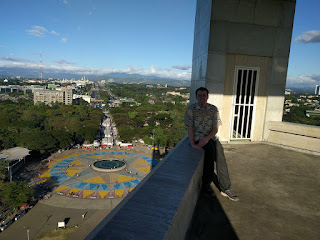The University of the Philippines is in one of the cities which makes up Metro Manila, called Quezon City. The city is named after Manuel Quezon (1878-1944). Quezon was instrumental in getting the United States to agree to give the Philippines independence, a plan which was agreed upon in the 1934 Tydings-McDuffie Act. This act created a transition period for the Philippines, where the Philippines would have a self-governing Commonwealth while the United States retained sovereignty until a deadline of 1946, when the Philippines would become independent. Quezon became the president of the new Commonwealth in 1935, a position he would hold until his death in 1944.
Sadly, Quezon died in the United States rather than in his beloved Philippines, since Japan conquered the Philippines in 1942, forcing the Commonwealth government to flee to the United States. It remained there until the reconquest of the Philippines in 1944-45. Therefore, after the Philippines became independent in 1946, the government immediately began plans to build a memorial to the late leader.
The monument was going to be in "Quezon City," then a suburb of Manila which had begun construction while Quezon was still president in the 1930s. The plan had been to relocate the capitol to Quezon City upon independence, but the Japanese occupation and the destruction of Manila in the reconquest of the Philippines interfered with those plans.
We often forget the loss of the Philippines in the United States when we remember World War II, but the occupation and the reconquest left the Philippines absolutely ravaged. At the time, it was said no cities were more devastated by the war than Warsaw and Manila. Here are some photos of Manila after the reconquest in 1945:
The Philippines have come a long way since 1945, though.
 |
| Quezon Memorial, AKA Isengard |
 |
| Ren Mark, my friendly guide |
Most important for me, nerd as I am, is the Quezon Museum in the Quezon Memorial tower. A history BA student who worked at the museum, named Ren Mark, was very welcoming to me, and showed me all over the museum.
He showed me the dresses of Mrs. Aurora Quezon:
And the surviving pieces of Quezon's office:
As well as Quezon's tomb, his remains having been returned to the Philippines from upstate New York after the war. Quezon wanted it to resemble Napoleon's tomb in the Hotel des Invalides:
Finally, and most generously, Ren Mark stayed late and took me up the tower, so I could experience Gandalf's imprisonment on the top of Isengard. Thankfully, I didn't have to catch a moth and get the Eagles to come rescue me (magical eagles, not Don Henley). Wonderfully, this gave me the best views of Manila I've ever had:
 |
| Looking down on the Quezon Circle, with the fountain at its center. |
 |
| Great view up Commonwealth Avenue, leading out toward the edge of Manila, and the mountains. |
 |
| Looking back toward the sea, and the heart of urban Manila. Gives you a sense of the city's size. |
 |
| A sunlit glimpse of the sea beyond all the buildings, to the north. |
 |
| Yours truly. Thanks to Ren Mark for the photo, and the privilege! |
***
And now for something completely different.



































